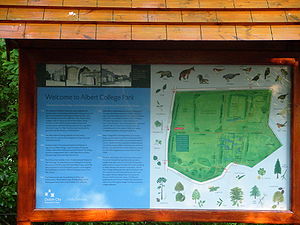
Albert College (Dublin)
Encyclopedia

Dublin City University
Dublin City University is a university situated between Glasnevin, Santry, Ballymun and Whitehall on the Northside of Dublin in Ireland...
and contains the offices of the university president, the DCU Educational Trust, and other executive offices of the university; the building dates from 1851. The Albert College Building also houses the 1838 Club, a restaurant for staff and postgraduate research students. The adjoining Albert College Extension contained laboratories for the school of engineering and was opened in 1985. The college is located in Glasnevin
Glasnevin
Glasnevin is a largely residential neighbourhood of Dublin, Ireland.-Geography:A mainly residential neighbourhood, it is located on the Northside of the city of Dublin . It was originally established on the northern bank of the River Tolka...
, Dublin, Ireland
Ireland
Ireland is an island to the northwest of continental Europe. It is the third-largest island in Europe and the twentieth-largest island on Earth...
.
History
In 1838, John Pitt Kennedy, the first inspector-general of the nascent Irish National School system, acquired land for the state for the specific purpose of building a central model farm and training establishment for National School teachers. The teachers were to be taught how to give instruction to children not only in reading, writing and arithmetic but also in practical and innovative methods of agriculture. Albert College started life as Glasnevin Model Farm in 1838, becoming the Albert National Agricultural Training Institution in 1853 after a visit by Prince Albert. The foundation of the college was an important event in the history of agricultural education in IrelandEducation in Ireland
The term Education in Ireland may refer to either of two education systems in Ireland:*Education in the Republic of Ireland*Education in Northern Ireland...
, which trained primary school teachers to the standards required by the Board of National Education in Ireland for the teaching of agriculture, additionally it also trained those whose aim was to pursue a career in agriculture. The board established twenty model agricultural schools and provided many national schools with small holdings or gardens. Because of religious opposition and laissez-faire
Laissez-faire
In economics, laissez-faire describes an environment in which transactions between private parties are free from state intervention, including restrictive regulations, taxes, tariffs and enforced monopolies....
economic policies, the board was forced to discontinue support for the schools holdings in 1863 and in 1874 disposed of most of the model farms. Albert College survived, probably because it was not exclusively concerned with the board's educational policies—it also carried out research
Research
Research can be defined as the scientific search for knowledge, or as any systematic investigation, to establish novel facts, solve new or existing problems, prove new ideas, or develop new theories, usually using a scientific method...
work in new crop varieties, farming methods and breeding livestock.
In 1902 the name Albert Agricultural College was adopted. In the early 20th century Paul A Murphy, Professor of plant pathology made a significant scientific breakthrough in the study of phytophthera infestans, the fungus which causes potato blight. In the definitive work on the Irish Famine - The Great Hunger - the author Cecil Woodham-Smith
Cecil Woodham-Smith
Cecil Blanche Woodham-Smith was a British historian and biographer. She wrote four popular history books, each dealing with a different aspect of the Victorian era.-Early life:...
states that in view of the fact that Ireland suffered so much from the blight it was "by a stroke of poetic justice that it was in Ireland that much of the final research was carried out... at the Albert College in Glasnevin, Dublin".
In 1926 the Faculty of Agriculture, University College, Dublin moved onto the site as a result of the University Education (Agriculture and Dairy Science) Act, 1926. In 1964 University College, Dublin approved the sale of 359 acres (145.3 ha) of the Albert College lands to Dublin Corporation
Dublin Corporation
Dublin Corporation , known by generations of Dubliners simply as The Corpo, is the former name given to the city government and its administrative organisation in Dublin between 1661 and 1 January 2002...
, 212 acres (85.8 ha) of these were on a separate northern site which is now Ballymun
Ballymun
Ballymun is an area on Dublin's Northside close to Dublin Airport, Ireland. It is infamous for the Ballymun flats, which became a symbol of poverty, drugs, alienation from the state and social problems in Ireland from the 1970s...
town center—the Albert College Park
Albert College Park (Dublin)
Albert College Park is a public park owned and managed by Dublin City Council Parks and Landscape Services Division. It is located on the Ballymun Road in Glasnevin next Dublin City University and is often called an oasis in the city....
lands were also transferred to Dublin Corporation at this time and continue to be used as a public park. The sale occurred because the imminent transfer of the Faculty of Agriculture to Belfield became apparent, also a housing crisis occurred in Dublin during the 1960s as a number of old, dilapidated buildings collapsed in the city and land for housing near the city became urgently required.
University College, Dublin finally vacated the site in 1979 and the fledgling NIHE, Dublin moved on site, vacating its inner city offices. In 1989 the NIHE
National Institute for Higher Education
A National Institute for Higher Education was a category of higher education institution established in the Republic of Ireland to provide higher level technical education above the standard of the then established Regional Technical College system but at university level...
became Dublin City University
Dublin City University
Dublin City University is a university situated between Glasnevin, Santry, Ballymun and Whitehall on the Northside of Dublin in Ireland...
, and continued its capital development plan on the 50 acres (20.2 ha) former Albert College lands that it owns.

